Gardening: Compost for the Cabin Terrace Garden Beds
The cabin terrace garden is growing hot peppers, cucumber plants, wild strawberry seedlings, cherry tomato vines, and kitchen herbs. The terrace was built seven weeks ago - Building the Garden Terrace and Lower Rock Retention Wall.
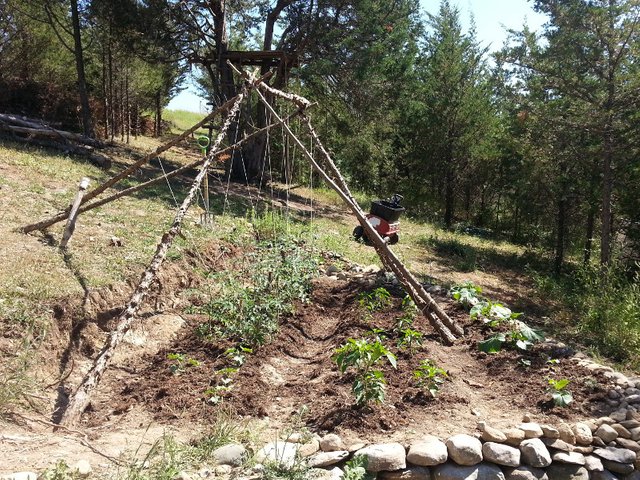
Twenty-five Days Ago...
Twenty-five days ago the seedlings were transplanted into the garden. I also added Garden Hose Drip Irrigation with Gravity and a .79mm Drill Bit to help keep the garden watered. There has been little rainfall for many weeks - the gravity fed drip irrigation system has saved a lot of time and energy.
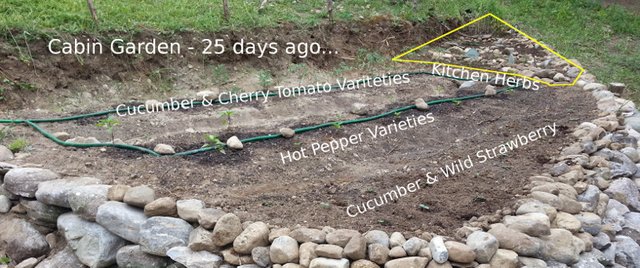
The Garden Now...
The garden has grown a lot the past twenty-five days. A week ago I added a trellis. The cherry tomato vines were strung up to the trellis after the branches were removed. A previous post - Stringing the Cherry Tomato Varieties up to the Trellis - shows how this is done.
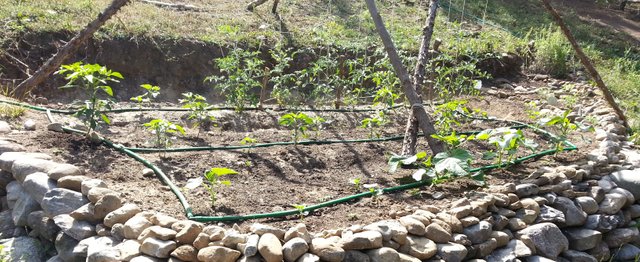
As you can see in the picture above, the clay and rock garden soil needed help.
The Composting Bin
In the early spring - when the material in the compost bin had thawed enough from winter to be turned - I heaped the compost along the gate-side corner to compost more thoroughly with potential hot composting action. In this previous post - Back Acres: Heaping the Compost in the Cubic Meter Bin for Hot Composting - I discuss the construction and hot composting potential of my cubic meter composting bin.
In the picture below you can see the chicken wire gate of the composting bin has been pulled up.

In the first picture below you can see the gate side of the composting bin where the compost had been heaped earlier in the spring. It has shrunk considerably in size. On the far side of the compost bin is where kitchen scraps, cardboard, and lawn clippings are added to the bin. In a few days I will add more lawn clippings to the bin and re-heap the pile onto the gate side, and give it a good watering.
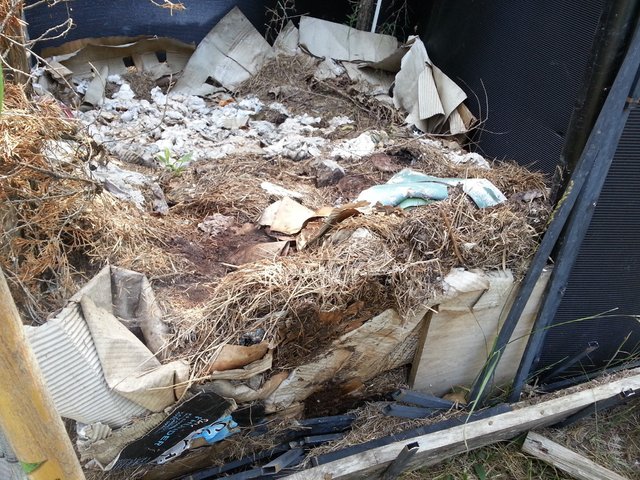
|
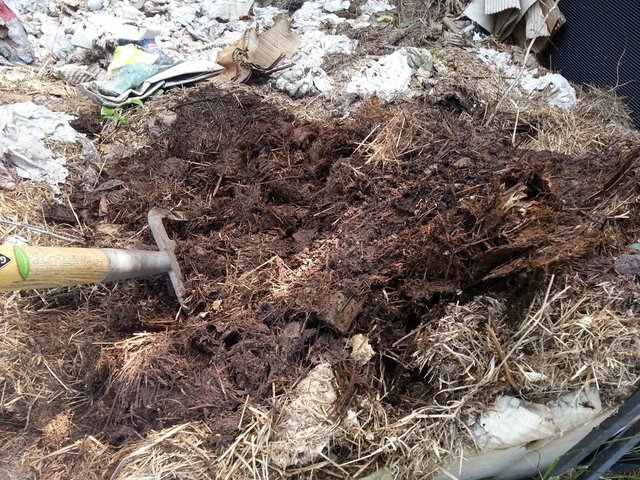
|
Removed Items that do not Compost
As I was spade forking my way through the compost, I would hear the odd crinkle of plastic packing tape or other items that do not compost. Some would get caught on the spading fork, some would catch my eye. I was sure to remove any items that do not compost during this whole process. You can see the pile of removed items below.
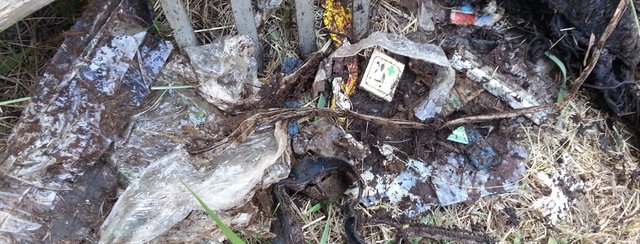
Wagon Loads of Compost
You can see the storage tote full of the aged compost - ready in the wagon for transport. Two of these wagon loads will give the garden beds a modest covering.
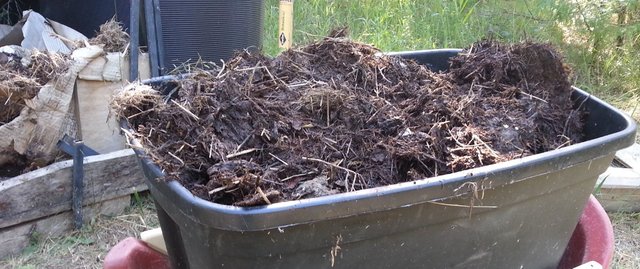
Red Worms Found in the Compost Bin
| I was happy to find red worms in the compost bin. Red worms are the type of worms that will help quickly break down compost into top quality soil for the garden. |

|
Compost Added to the Garden
In the picture below you can see how the compost was added to the garden beds. The compost will help with suppressing weeds and preventing moisture loss. The mature compost will also attract worms to the garden, provide some nutrients to the plants, and will improve the clay and rock soil when mixed in at the start of each season.
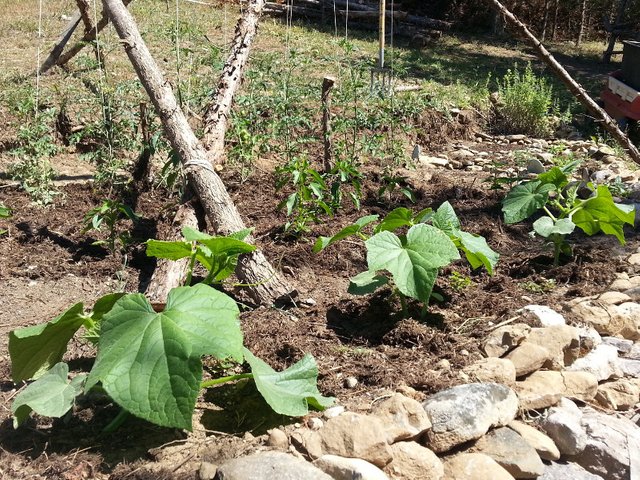
The Growing Garden
In the first picture below you can see one of the Cayenne Chili Pepper plants - two peppers and lots of blooms. The Cucumber plants will be spreading out with their vines soon enough. I considered having them climb a rope to the trellis, but i didn't want to shade the hot pepper plants, so I will have the cucumbers cascade down the terrace wall.
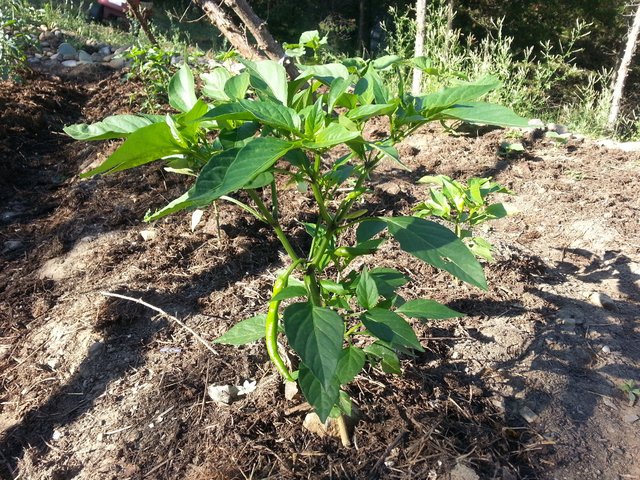
|
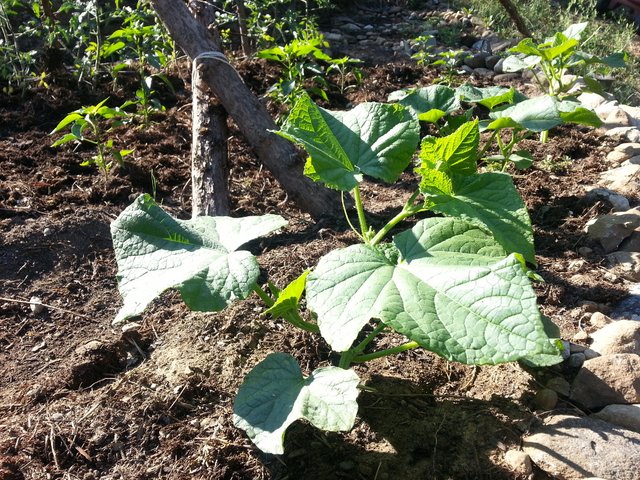
|
The cherry tomato varieties are growing just as well up here as they are down in the main tomato production garden. The day I went to the cabin terrace garden to string up the tomato plants, one of them in the picture below was laying on the ground from the weight of the tomatoes - Sakura variety of course.
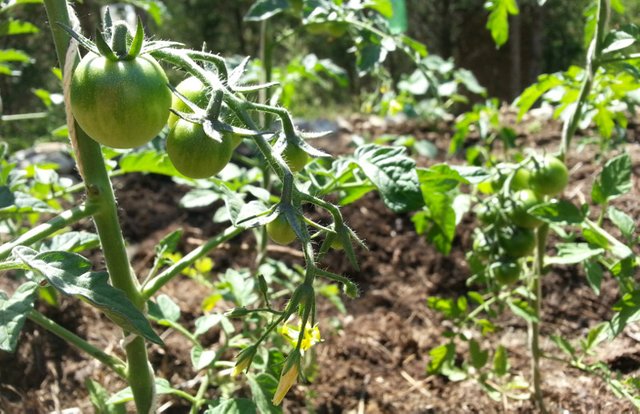
nice to see the tomatoes coming along well.
your mention of composting has reminded me of something i read about using 'active' compost as a heat source, i cant quite remember the context but i think it was useful for keeping the top soil warmer and protecting seedlings from frost. you may be able to shed more light on it than me?
This heatwave is set to continue,not sure about canada but definitely over here for another 4 weeks i think. literally everything is dying, all the grass everywhere is dry...and im really miserable as its too hot for me
Our soil was crap when we first came here too. We have been mulching and adding compost to the gardens for almost 7 years. I think we are finally seeing really good results...
I'll most likely end up having a couple cubic yards of good top soil delivered to give the production garden rows a boost for next year. I do have plenty of brush to make char to help break up the clay and rock a little, but we're under a fire ban right now due to lack of rain, so that will have to wait.
We are supposed to be in the rainy season and we have had no ain either...
Very nice . I am soo jelly of being able to garden. Pepers, cukes and cherry tomatoes...nice. RESPECT brother. Can I squat on your property? LOOL
We're focused on developing the salad veggies for the market, some baby root veggies too- lettuce eventually, might get one crop in this season. This summer's been the summer of digging - can squat any time - bring shovels :D
We found that the most efficient way to make compost is to let the chickens do the work. The chickens lived on our garden plot for a while and we gave them chopped leaves about 6" to 12" deep. The worms come up to the top of the soil and each hen will make a hole down through the mulch to find them. As they scratch for worms the hole migrates around the garden and they turning and mixing the leaves. A foot of chopped leaves turned into about 4" of rich topsoil in less than a year. We just moved the fence for the chicken yard over to a new spot and started over the next year. Our soil is sticky red clay.
Thanks, that's a great idea with the chickens - I have been making plans for eventually getting a few egg laying hens, and have thought about laying a thick layer of bedding to eventually compost and replace, but I didn't consider the arrival of the worms. Moving the fencing around to rehabilitate different parts of the property is a good plan too. The clay's like cement after baking in the sun. I have to give the wild strawberries in their strawberry patch credit, I didn't add much top soil when I put that garden in last summer and when I went to transplant more into the garden this spring the ground was hard as a rock lol, much work to do on the soil.
Our winter in Virginia is mild enough so that the chickens don't need a fully enclosed house. The chicken house is on wheels and has a mesh bottom so that I don't have to clean it out, just wheel it to a new spot periodically.
My sister is a farmer. She says that chickens are like the gateway drug to animal husbandry.
Love your posts. They are so well done with the photos, how to info, graphics. Great content. Just what Steemit needs! My son did a composting project for school. Watching for worms and other insects is a great way to figure out if its working well.
Thanks, that sounds like a great school project. I've known about the red worms - but thought I would have to buy some, so I was pretty happy to see that they just showed up :)
Looking pretty good.. Are you tihnking about taking any measures for pest control / animals eating the crop?
As time goes by the soil will probably get better i should imagine..
Great work man.
Thanks, I'm not too worried about pests so much with the tomatoes and peppers - the cucumbers should be ok too for now. Next year I'll be starting those crops in a greenhouse so they'll get protected that way - though i'm sure they'll develop their own set of bug problems, i'll most likely go with lady bugs if need be. The main crops I would worry about would be any of the lettuces, greens, root veggie tops, cabbage, etc - those i'll be covering with poly-clear plastic low tunnel row covers that i'll most likely swap out for but netting in the hot part of the summer to keep them cooler. I have a 100 ft x 10 ft wide roll of 8 mil poly plastic on hand, and two 10 ft x 50 ft wide rolls of netting on the way - deciding if I want to go with the rebar for posts and electrical conduit for row hoops, or if i'll try to make something with tripods lol :)
My experience has been if the soil is brought into balance, the pests and diseases disappear. Then there is no need for barriers or other remedies... Now is the time to start thinking about amending the soil and planning soil tests, to be done in November or the end of the growing season.
Food for thought...
The poly low tunnels are to help extend the growing season, help protect from wind, the odd hail storm, and the netting will act as a shade cloth to keep them cooler in the summer. I dont have a garden fence, so the covering will help prevent Rabbits from eating their favorite crops.
I agree, fencing of some sort is crucial to having undamaged crops. I thought I had read, in the response, a swap out for bug netting when it got hot. That was what I was responding to....
You are a busy man here I can see.. but I bet you are quite proud of what you're building there too :-)
What a cool garden, I love how far it has come already, I would love to grow one but I know they take a lot of work to maintain.
Congratulations, your post received 36.67% up vote form @spydo courtesy of @jackdub! I hope, my gratitude will help you getting more visibility.
You can also earn by making delegation. Click here to delegate to @spydo and earn 95% daily reward payout! Follow this link to know more about delegation benefits.
The price for our service has increased to 0.150 or 0.151 SBD, Thank you.